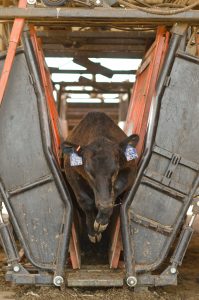If the last time you bought new cattle working equipment was when the Dallas Cowboys were Super Bowl Champions, it might be time to consider an upgrade.
Here are some practical tips on safety features to look for in head gates, chutes and working facilities, straight from some of the people who make them:
Match your equipment to your herd
One thing Pearson Livestock Equipment owner David Rater says to consider is whether you need a manual or self-catch head gate.
“Let’s say you have horned Hereford cattle. Then you do not want a self-catch head gate. That’s going to cause you a lot of headaches and wrecks. You need a manual head gate because of the horns,” he explains. “But if you have an Angus herd and everything is polled, then you need to consider a self-catch head gate. It’s easy — you can even work cattle by yourself.”
Rater adds that, if you are shopping for a manual head gate, you should make sure it can be worked at the head and the rear of the chute.
“That’s important because if you’re working cattle by yourself sometimes, you need to be able to catch them in the head gate,” he says.

Ease of use
Of course, you need a new chute to be functional,” says Cody Hammill of Arrowquip. “But you also need to pay attention to ease of use, because if using that chute is hard and you get tired and worn out, everything can fall apart that much faster.”
Check the handles and levers
“Some chutes have handles that stick out and if you don’t watch what you’re doing, you might wind up with one of those in the forehead. You don’t want to have to wear a hard hat when you’re working cattle,” says Joey Gamble of Priefert Manufacturing.
Check your alley
“You would want to pay some attention to your alley and make sure you have one that adjusts well,” adds Arrowquip’s Steve Langrell. “And make sure it’s still going to work when things freeze up in winter. To have a decent, adjustable alley is quite a big deal. If it’s full width all the time, you’ll get some pretty good-sized animals trying to turn around.”
Match your handling skills
Everyone has their own opinion on handling philosophies, but Langrell believes tubs are better than a Bud Box for ranchers who don’t work cattle as often as others because it’s harder to empty the Bud Box, even though they are very effective. Some operators prefer high sheeting on the sides and others don’t. If you aren’t sure what you need, set up an appointment with a rep to come out to your place and discuss it.
Want to read more on cattle equipment? Watch the January issue of The Cattleman for our feature story on chuteside safety tips.
-Sharla
Sharla Ishmael is a freelance writer from Benbrook.
PO BOX 101988
FORT WORTH, TX 76185
1-800-242-7820
© 2023 Texas & Southwestern Cattle Raisers Association; All Rights Reserved.
